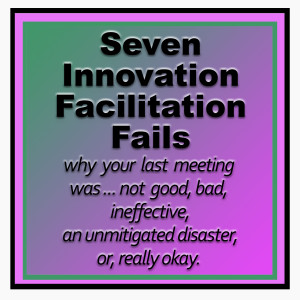 Facilitation of Innovation Meetings Requires a Highly Specific Set of Skills, Frameworks, Tools — and Experience
Facilitation of Innovation Meetings Requires a Highly Specific Set of Skills, Frameworks, Tools — and Experience
Professional Facilitation and/or Training Makes a Difference*
Seven Facilitation Fails
Innovation projects are about a lot of meetings.
Meetings about getting a project mandate, visioning, what to innovate, how to innovate, challenges to take on, jobs to do, experiences to create, research exploration, insights development, problem framing and problem reframing, project road-mapping, concept development, prototyping, pitches, strategy, check-ins, and all the variations. And not necessarily in that order.
Meetings take up precious time, and, are dead essential to moving the ball downfield. It’s sad, and, a missed opportunity, that many meetings are outright fails when it comes to measurable results. Do any of the following Seven Fails ring true?
Seven Facilitation Fails:
- Most innovation project managers haven’t been trained in facilitation. They may know frameworks, like Design Thinking or Agile, and a few tools, but very few have the extensive training and experience at hands-on facilitation required to make a difference.
- Those who have been trained, don’t get enough practice. If you’ve facilitated a tool once or twice, it may work, or, you may fail. When you’ve done it 20 times, you don’t fail.
- Internal leaders have vested interests and are focused on content, not process. A good facilitator needs to be process focused and neutral on content. Usually the opposite is true, and, it causes a fail. Neutrality allows a group to be fully expressed within a structure, a plan.
- Internal leaders fail because of tool poverty. Professional facilitators know more tools, techniques, and frameworks. If you only have a hammer, everything looks like a nail. There are specific tools for visioning, problem framing, and ideation etc. There are situations where tools need to be introvert friendly. Or focused on writing, or pitching. Professional facilitators know which tool to use, in a complex context, to boost a meetings results.
- Internal facilitators do hasty planning. Professional facilitators have time and experience to plan — and that is a key to success. As an example, most brainstorming sessions fail because the challenge is not properly framed. They also fail because teams are starting cold. Homework can warm them up, but that has to be planned and assigned. Doing the hard and detailed preparation work ahead of time can save the entire meeting — or project, from failure.
- Internal facilitators step in obvious holes. Professional facilitators know how to avoid classic pitfalls and mistakes. What happens, for instance, when someone is dominating a group? How that is handled will determine the outcome of your meeting. A professional facilitator has ways to stop the behaviour — and make people think it was their idea.
- Internal facilitators don’t ask. Professional facilitators can ask your team to do things that are different. You’re more likely to get better results if you try new things, and those might be uncomfortable for the group. A professional facilitator knows how to frame up an uncomfortable request and get a group doing the unexpected. An outsider often gets the benefit of the doubt and more professional respect than a familiar insider.
When you need a meeting to go smoothly and get results, consider a professional facilitator. Or, get the extensive training and practice needed to make an internal leader into a true facilitation pro.
* Apologies in advanced to those wonderful leaders, facilitators, and project managers who are in fact highly skilled at meeting facilitation. They do exist — and you know who you are — this post generalizes to make a point that doesn’t apply to you.



2 responses to “Seven Facilitation Fails”
as an Internal Fortune 50 company Facilitator, I could not agree more with this statement. I am have facilitation as key deliverable but observe this behavior stated above every day. “Leaders” think they know the facilitation process BUT dive so deep in content. “Self facilitation” is like running into a burning building. Teams should heed Gregg’s advice and seek professional guidance.
Thanks for your comment Shannon, yes, love the burning building image, that’s it exactly.